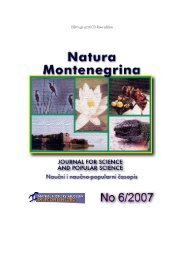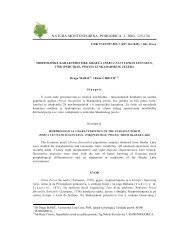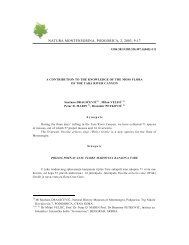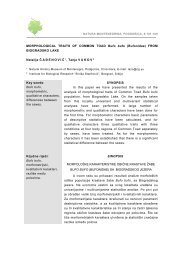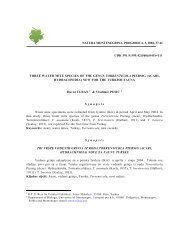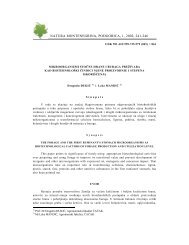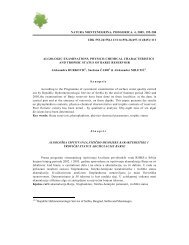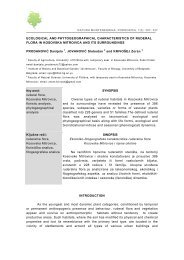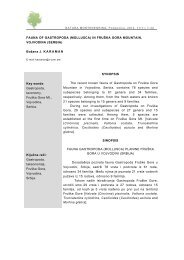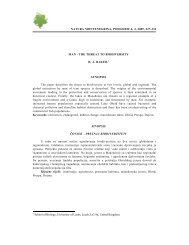THE USE OF EYE LENS DIAMETER AND WEIGHT IN AGE ...
THE USE OF EYE LENS DIAMETER AND WEIGHT IN AGE ...
THE USE OF EYE LENS DIAMETER AND WEIGHT IN AGE ...
Create successful ePaper yourself
Turn your PDF publications into a flip-book with our unique Google optimized e-Paper software.
Natura Montenegrina 11(1), 2012<br />
CRIVILLI, 1980; SALEEM et al., 1990; DOUGLAS, 1987; AL-HASSAN et al., 1991,<br />
1992; AL-HASSAN & AL-SAYAB, 1994; CONIDES & AL-HASSAN, 2000; JAWAD,<br />
2001, 2003, 2004; JAWAD et al., 2001).<br />
Age determination is an important step in the process of studying growth in<br />
fish species. The method involves counting of scale or otolith annuli and usually<br />
requires the measurements of a large number of specimens (FLETCHER, 1991).<br />
Otolith and scale readings require a variable and considerable effort to prepare each<br />
specimen and even then the readings are subject to both systematic and random<br />
errors in interpretation and require independent validation (BEAMISH, 1979). Thus,<br />
a considerable time is needed to acquire the skill necessary for consistent<br />
interpretation of the materials. In addition, extra readings are usually needed in<br />
order to verify the age assigned to a specimen (S<strong>AND</strong>ERMANN, 1969).<br />
The aim of this study is to determine the validity of the eye lens diameter and<br />
weight as age indicators in the Arabian Sea fish, S. canaliculatus and to establish a<br />
faster method for ageing fishes beside the conventional methods of scale and<br />
otolith.<br />
MATERIAL <strong>AND</strong> METHODS<br />
Specimens of Siganus canaliculatus (387) were collected from the coasts of<br />
Salalah City at the Arabian Sea during the period January 2010-August 2010. Fishes<br />
were taken to the laboratory and the diameter and weight of the eye lens were taken<br />
to the nearest mm and g respectively following the procedure of JAWAD et al.<br />
(2004). The lenses were extracted, dried at room temperature (25°C). The<br />
measurement of the lens in each side of the animal was kept separate. The large<br />
bone such as operculum and preoperculum were used to determine the age<br />
following AL-HASSAN & AL-HASSAN (1994). The bones on both left and right sides<br />
were twice read independently, using an ordinary dissecting microscope for<br />
verification. One way analysis of variance followed by Duncan's multiple range test<br />
(HARRAWAY, 1997) were applied to test the differences between the total length of<br />
the fish and its age.<br />
GERK<strong>IN</strong>G (1966) showed how different environmental factors could alter the<br />
growth rate in the bluegill Lepomis macrochirus Rafinesque, 1819 and SWEDBERG<br />
(1965) summarized the various growth rates of drum, Aplodinotus grunniens<br />
Rafinesque, 1820 from different areas in the United States. Environmental<br />
conditions must be considered in applying the lens technique (BURKETT &<br />
JACKSON 1971). CRIVILLI (1980), working on carp, stated that in the reproductive<br />
period energy is transformed from somatic to gonadal growth.<br />
74



